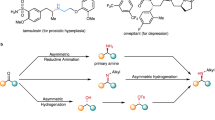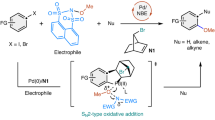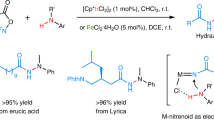Abstract
Aromatic rings are ubiquitous in organic chemistry and form the basis of many commercial products. Despite the numerous routes available for the preparation of aromatic compounds, there remain few methods that allow their conversion into synthetically useful partially saturated derivatives and even fewer that allow new C–C bonds to be formed at the same time. Here we set out to address this problem and uncover a unique catalytic partial reduction reaction that forms partially saturated azaheterocycles from aromatic precursors. In this reaction, methanol and formaldehyde are used for the reductive functionalization of pyridines and quinolines using catalytic iridium; thus, inexpensive and renewable feedstocks are utilized in the formation of complex N-heterocycles. By harnessing the formation of a nucleophilic enamine intermediate, the C–C bond-forming process reverses the normal pattern of reactivity and allows access to the C3 position of the arene. Mechanistic investigations using D-labelling experiments reveal the source of hydride added to the ring and show the reversible nature of the iridium-hydride addition.
This is a preview of subscription content, access via your institution
Access options
Access Nature and 54 other Nature Portfolio journals
Get Nature+, our best-value online-access subscription
$29.99 / 30 days
cancel any time
Subscribe to this journal
Receive 12 print issues and online access
$259.00 per year
only $21.58 per issue
Buy this article
- Purchase on Springer Link
- Instant access to full article PDF
Prices may be subject to local taxes which are calculated during checkout



Similar content being viewed by others
Data availability
Supplementary information, chemical compound information and copies of spectra are available in the online version of this paper.
References
Baumann, M. & Baxendale, I. R. An overview of the synthetic routes to the best selling drugs containing 6-membered heterocycles. Beilstein J. Org. Chem. 9, 2265–2319 (2013).
Majumdar, K. C. & Chattopadhyay, S. K. Heterocycles in Natural Product Synthesis (Wiley-VCH, Weinheim, 2011).
Blakemore, D. C. et al. Organic synthesis provides opportunities to transform drug discovery. Nat. Chem. 10, 383–394 (2018).
De Vries, J. G. & Elsevier, C. J. in Handbook of Homogeneous Hydrogenation Ch. 16 (Wiley-VCH, Weinheim, 2008).
Kӓllstrӧm, S. & Leino, R. Synthesis of pharmaceutically active compounds containing a disubstituted piperidine framework. Bioorg. Med. Chem. 16, 601–635 (2008).
Glorius, F., Spielkamp, N., Holle, S., Goddard, R. & Lehmann, C. W. Efficient asymmetric hydrogenation of pyridines. Angew. Chem. Int. Ed. 43, 2850–2852 (2004).
Renom-Carrasco, M. et al. Asymmetric hydrogenation of 3-substituted pyridinium salts. Chem. Eur. J. 22, 9528–9532 (2016).
Wang, X.-B., Zeng, W. & Zhou, Y.-G. Iridium-catalysed asymmetric hydrogenation of pyridine derivatives, 7,8-dihydro-quinolin-5(6H)-ones. Tetrahedron Lett. 49, 4922–4924 (2008).
Tang, W.-J. et al. Highly enantioselective hydrogenation of quinoline and pyridine derivatives with iridium-(P-phos) catalyst. Adv. Synth. Catal. 352, 1055–1062 (2010).
Ye, Z.-S. et al. Iridium-catalysed asymmetric hydrogenation of pyridinium salts. Angew. Chem. Int. Ed. 51, 10181–10184 (2012).
Chang, M. et al. Asymmetric hydrogenation of pyridinium salts with an iridium phosphole catalyst. Angew. Chem. Int. Ed. 53, 12761–12764 (2014).
Kita, Y., Iimuro, A., Hida, S. & Mashima, K. Iridium-catalysed asymmetric hydrogenation of pyridinium salts for constructing multiple stereogenic centres on piperidines. Chem. Lett. 43, 284–286 (2014).
Huang, W.-X. et al. Iridium-catalysed selective hydrogenation of 3-hydroxypyridinium salts: a facile synthesis of piperidin-3-ones. Org. Lett. 17, 1640–1643 (2015).
Rupeing, M. & Antonchick, A. P. Organocatalytic enantioselective reduction of pyridines. Angew. Chem. Int. Ed. 46, 4562–4565 (2007).
Taber, D. F. & Lambert, T. in Organic Synthesis Ch. 27–31 (Oxford Univ. Press, Oxford, 2015).
Wu, J., Tang, W., Pettman, A. & Xiao, J. Efficient and chemoselective reduction of pyridines to tetrahydropyridines and piperidines via rhodium-catalyzed transfer hydrogenation. Adv. Synth. Catal. 355, 35–40 (2013).
Talwar, D., Li, H. Y., Durham, E. & Xiao, J. A simple iridicycle catalyst for efficient transfer hydrogenation of N-heterocycles in water. Chem. Eur. J. 21, 5370–5379 (2015).
Comins, D. L., Joseph, S. P. & Goehring, R. R. Asymmetric synthesis of 2-alkyl(aryl)-2,3-dihydro-4-pyridones by addition of Grignard reagents to chiral 1-acyl-4-methoxypyridinium salts. J. Am. Chem. Soc. 116, 4719–4728 (1994).
Charette, A. B., Grenon, M., Lemire, A., Pourashraf, M. & Martel, J. Practical and highly regio- and stereoselective synthesis of 2-substituted dihydropyridines and piperidines: application to the synthesis of (–)-coniine. J. Am. Chem. Soc. 123, 11829–11830 (2001).
Fernández-Ibáñez, M. Á., Maciá, B., Pizzuti, M. G., Minnaard, A. J. & Feringa, B. L. Catalytic enantioselective addition of dialkylzinc reagents to N-acylpyridinium salts. Angew. Chem. Int. Ed. 48, 9339–9341 (2009).
Donohoe, T. J., Connolly, M. J. & Walton, L. Regioselective nucleophilic addition to pyridinium salts: a new route to substituted dihydropyridines. Org. Lett. 11, 5562–5565 (2009).
Nadeau, C., Aly, S. & Belyk, K. Rhodium-catalyzed enantioselective addition of boronic acids to N-benzylnicotinate salts. J. Am. Chem. Soc. 133, 2878–2880 (2011).
Chau, S. T., Lutz, J. P., Wu, K. & Doyle, A. G. Nickel-catalyzed enantioselective arylation of pyridinium ions: harnessing an iminium ion activation mode. Angew. Chem. Int. Ed. 52, 9153–9156 (2013).
Lutz, J. P., Chau, S. T. & Doyle, A. G. Nickel-catalyzed enantioselective arylation of pyridine. Chem. Sci. 7, 4105–4109 (2016).
Moran, J., Preetz, A., Mesch, R. A. & Krische, M. J. Iridium-catalysed direct C–C coupling of methanol and allenes. Nat. Chem. 3, 287–290 (2011).
Garza, V. J. & Krische, M. J. Hydroxymethylation beyond carbonylation: enantioselective iridium-catalyzed reductive coupling of formaldehyde with allylic acetates via enantiotopic π-facial discrimination. J. Am. Chem. Soc. 138, 3655–3658 (2016).
Elangovan, S. et al. Efficient and selective N-alkylation of amine with alcohols catalysed by manganese pincer complexes. Nat. Commun. 7, 12641 (2016).
Olah, G. A. Towards oil independence through renewable methanol chemistry. Angew. Chem. Int. Ed. 52, 104–107 (2013).
Sam, B., Breit, B. & Krische, M. J. Paraformaldehyde and methanol a C1 feedstocks in metal catalysed C–C couplings of π-unsaturated reactants: beyond hydroformylation. Angew. Chem. Int. Ed. 54, 3267–3274 (2015).
Natte, K., Neumann, H., Beller, M. & Jagadeesh, R. V. Transition-metal-catalyzed utilization of methanol as a C1 source in organic synthesis. Angew. Chem. Int. Ed. 56, 6384–6394 (2017).
Hamid, M. H. S. A., Slatford, P. A. & Williams, J. M. J. Borrowing hydrogen in the activation of alcohols. Adv. Synth. Catal. 349, 1555–1575 (2007).
Chan, L. K. M., Poole, D. L., Shen, D., Healy, M. P. & Donohoe, T. J. Rhodium-catalyzed ketone methylation using methanol under mild conditions: formation of alpha-branched products. Angew. Chem. Int. Ed. 53, 761–765 (2014).
Shen, D. et al. Hydrogen borrowing and interrupted hydrogen borrowing reactions of ketones and methanol, catalysed by iridium. Angew. Chem. Int. Ed. 54, 1642–1645 (2015).
Wang., S.-G. & You, S.-L. Hydrogenative dearomatization of pyridine and an asymmetric aza-Friedel–Crafts alkylation sequence. Angew. Chem. Int. Ed. 53, 2194–2197 (2014).
Sundararaju, B., Achard, M., Sharma, G. V. M. & Bruneau, C. sp 3 C–H bond activation with ruthenium(ii) catalysts and C(3)-alkylation of cyclic amines. J. Am. Chem. Soc. 133, 10340–10343 (2011).
Tan, Z., Jiang, H. & Zhang, M. Ruthenium-catalyzed dehydrogenative β-benzylation of 1,2,3,4-tetrahydroquinolines with aryl aldehydes: access to functionalized quinolines. Org. Lett. 18, 3177–3177 (2016).
Wu, J., Wang, C., Tang, W., Pettman, A. & Xiao, J. The remarkable effect of a simple ion: iodide-promoted transfer hydrogenation of heteroaromatics. Chem. Eur. J. 18, 9525–9529 (2012).
Wu, J., Talwar, D., Johnston, S., Yan, M. & Xiao, J. Acceptorless dehydrogenation of nitrogen heterocycles with a versatile iridium catalyst. Angew. Chem. Int. Ed. 52, 6983–6987 (2013).
Acknowledgements
The EPSRC (grant no. EP/L023121/1 and a DTP award) and Eli-Lilly provided financial support for this project.
Author information
Authors and Affiliations
Contributions
A.G. and T.J.D. conceived and designed the study. A.G., H.B.H., P.J.S. and H.K.P. performed the experiments and A.G., H.B.H., P.J.S., H.K.P., P.J.L.-S. and T.J.D. analysed the data for the compounds. A.G., H.B.H. and T.J.D. co-wrote the paper.
Corresponding author
Ethics declarations
Competing interests
The authors declare no competing interests.
Additional information
Publisher’s note: Springer Nature remains neutral with regard to jurisdictional claims in published maps and institutional affiliations.
Supplementary information
Supplementary information
Full synthetic protocols for the synthesis of all starting materials and products, full characterization data and spectra for all novel starting materials and products, additional screening information and additional mechanistic experiments
Rights and permissions
About this article
Cite this article
Grozavu, A., Hepburn, H.B., Smith, P.J. et al. The reductive C3 functionalization of pyridinium and quinolinium salts through iridium-catalysed interrupted transfer hydrogenation. Nature Chem 11, 242–247 (2019). https://doi.org/10.1038/s41557-018-0178-5
Received:
Accepted:
Published:
Issue Date:
DOI: https://doi.org/10.1038/s41557-018-0178-5
This article is cited by
-
Reaction strategies for the meta-selective functionalization of pyridine through dearomatization
Molecular Diversity (2024)
-
Intermolecular diastereoselective annulation of azaarenes into fused N-heterocycles by Ru(II) reductive catalysis
Nature Communications (2022)
-
Synthesis of chiral piperidines from pyridinium salts via rhodium-catalysed transfer hydrogenation
Nature Catalysis (2022)
-
Modular synthesis of chiral 1,2-dihydropyridines via Mannich/Wittig/cycloisomerization sequence that internally reuses waste
Nature Communications (2021)
-
Interrupted reactions in chemical synthesis
Nature Reviews Chemistry (2021)



